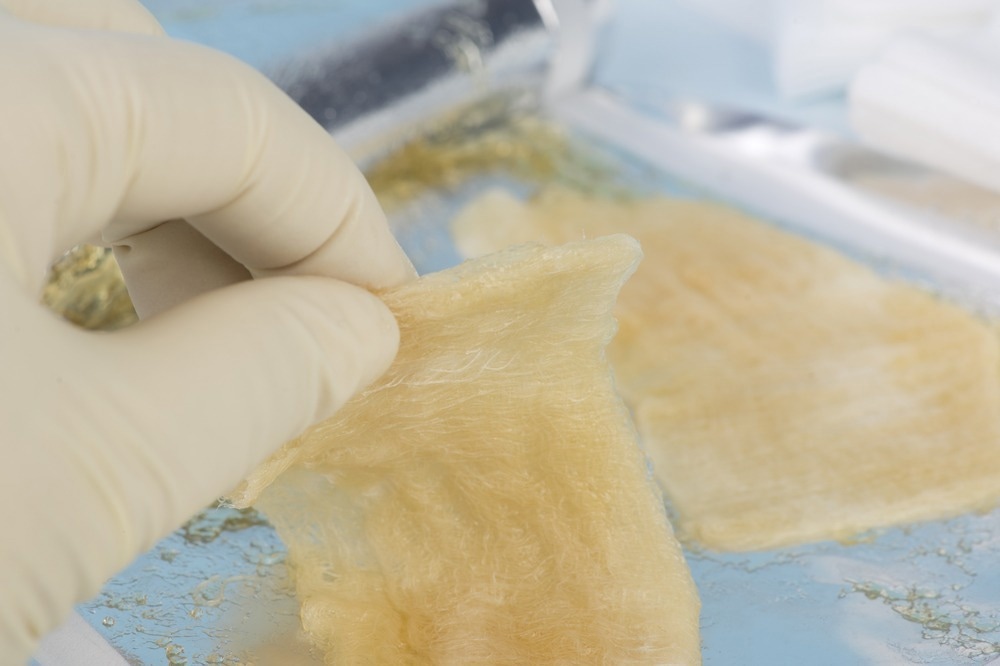What are hydrogels?
Natural vs. Synthetic Hydrogels
Uses of Hydrogels in Biomedicine
Drug Delivery
Tissue engineering
Hygiene products
Wound dressings
Future outlook
References
What are hydrogels?
Since hydrogels were first developed in the 1960s, they have grown in popularity, especially among scientists. Hydrogels have a vast array of potential in many areas of scientific research. But what are hydrogels, and why are they so important?
Hydro-Gel means water-gel, in which the gel’s major constituent is water. Hydrogels are primarily polymer mesh that can absorb large quantities of liquid, giving them a high water content; this gives them unique properties such as flexibility, softness, biodegradability, and biocompatibility. All these characteristics are very useful in biomedicine, as it resembles living tissues closely. They are currently being used in the production of contact lenses, hygiene products, tissue engineering, and many more.

Image Credit: MedstockPhotos/Shutterstock.com
Natural vs. Synthetic Hydrogels
Natural hydrogels are sourced from natural origins. There are many advantages to using natural hydrogels, such as biodegradability, biocompatibility, and non-toxicity. Some natural polymers used in manufacturing hydrogels include proteins from the human body, such as fibrin and collagen.
Synthetic hydrogels are sourced from synthetic polymers. Using synthetic polymers in hydrogels has advantages, such as the greater ability to absorb water, long life, and high strength. Polyethylene glycol (PEG) is one of the most popular synthetic polymers used in hydrogels for tissue engineering and bone prosthesis. PEG does not stimulate the immune system, therefore, preventing autoimmunity. There are also a group of semi-synthetic polymers that combine synthetic and natural polymers to utilize both benefits.
Uses of Hydrogels in Biomedicine
Drug Delivery
The use of hydrogels in drug delivery has promising effects and is gradually increasing in use. The high porosity of the hydrogel structure can be controlled by changing the density of the cross-links in the hydrogels. The porosity allows drugs to be loaded and released; this has the advantage of a sustained drug release and allows for better control of drug delivery over long periods. Some of the mechanisms of hydrogel delivery include topical and transdermal. Transdermal delivery involves the diffusion of the drug through the dermis and into capillaries and is useful in providing continuous controlled delivery of drugs into the blood circulation.
Tissue engineering
There is a large number of patients suffering from tissue or organ loss, and with the lack of donors, the problem is not easing. A new application of hydrogels is in tissue engineering. Hydrogel scaffolds have been used to engineer and transplant many tissues; cartilage, bone, and muscle. There has been a vast array of research into hydrogel scaffolds made from different polymers, some deriving from human hair and nails (keratin) and others from fungi. It has been suggested that the hydrogel scaffold should be made of more than one component or a ‘hybrid’ material for better cell proliferation and differentiation results.
Hygiene products
Superabsorbent polymers (SAPs) are widely used in the diaper industry and feminine hygiene products. SAPs are hydrophilic polymers that have excellent water retention properties. However, they put a heavy strain on the environment as they are not biodegradable and significantly increase in size when used, which can be uncomfortable for the user and cause nappy rash. A good solution would be using super porous hydrogels (SPH). Some SPHs, such as cellulose-based hydrogels, are completely biodegradable, allowing humans to cut down on the ecological impact they cause.
SPHs have high elasticity and do not swell nearly as much as SAPs, even after use. This characteristic allows for better skin health by holding moisture away from the skin, preventing nappy rash, and giving a more comfortable experience. However, more research is needed in this field as SPHs are still not used by the major producers in the industry.
Hydrogels, an unexplored material | Alvaro Charlet | TEDxLausanne
Wound dressings
Many characteristics prevent wound healing correctly, such as maceration, necrosis, pressure, and infection. This is why most wounds require dressings for protection. Plain gauze is the most used wound dressing as it is cheap and readily available. However, the problem with gauze is the removal process which can be painful and may strip away newly formed skin. Fortunately, there is an alternative option that uses hydrogel as a component.
Hydrogels are included in pastes for wound care, moist dressings, and debriding agents (which facilitate the elimination of dead cells). The advantages of using hydrogels as wound dressings include; increasing collagen production, increasing moisture, absorbing contaminated exudate, and allowing oxygen transmission to the wound. These all help prevent infections, increase the healing rate, and avoid adherence to wound surface, making the patient experience more comfortable. However, more research is needed for these dressings to become more cost-effective.
Future outlook
Although hydrogels are widely used in many sectors, their use is not as well established in tissue engineering and drug delivery. There have been many studies in these fields to increase the use of hydrogels, producing some innovative devices which have even been patented. However, the full potential of hydrogels in many areas of science is yet to be explored, leaving a lot of hope for the future.
References:
- Hossein Chamkouri, Mahyodin Chamkouri. (2021) A Review of Hydrogels, Their Properties, and Applications in Medicine. Am J Biomed Sci & Res. - 11(6). AJBSR.MS.ID.001682. DOI: 10.34297/AJBSR.2021.11.001682.
- Ho, T. C., Chang, C. C., Chan, H. P., Chung, T. W., Shu, C. W., Chuang, K. P., Duh, T. H., Yang, M. H., & Tyan, Y. C. (2022). Hydrogels: Properties and Applications in Biomedicine. Molecules (Basel, Switzerland), 27(9), 2902. https://doi.org/10.3390/molecules27092902
- Caló, E., & Khutoryanskiy, V.V. (2015). Biomedical applications of hydrogels: A review of patents and commercial products. European Polymer Journal, 65, 252-267.
Further Reading